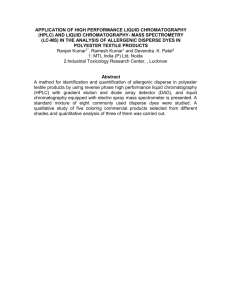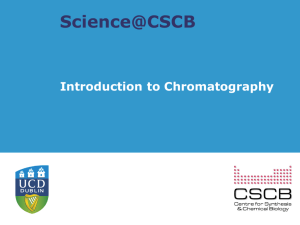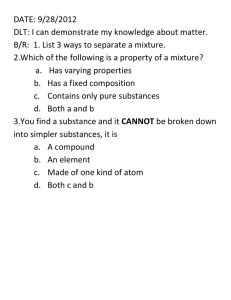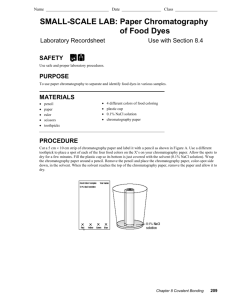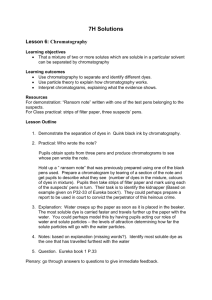5 Chromotagraphy - sciencelanguagegallery
advertisement
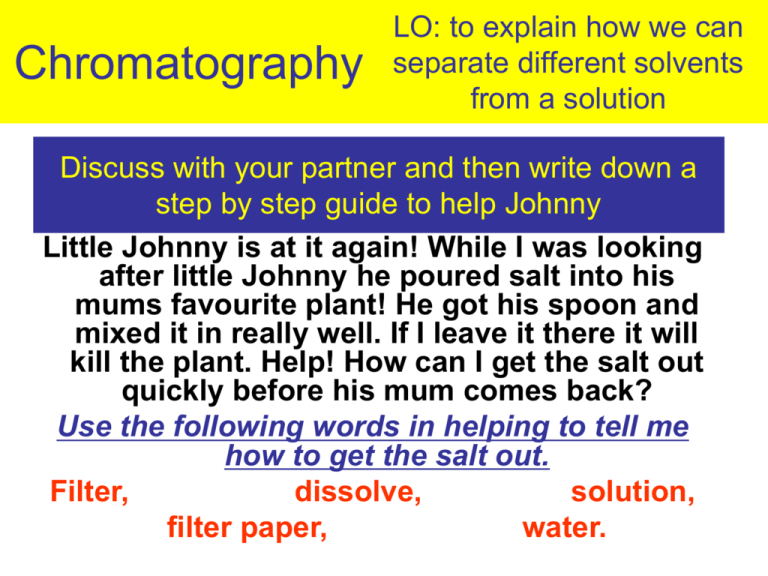
Chromatography LO: to explain how we can separate different solvents from a solution Discuss with your partner and then write down a step by step guide to help Johnny Little Johnny is at it again! While I was looking after little Johnny he poured salt into his mums favourite plant! He got his spoon and mixed it in really well. If I leave it there it will kill the plant. Help! How can I get the salt out quickly before his mum comes back? Use the following words in helping to tell me how to get the salt out. Filter, dissolve, solution, filter paper, water. Chromatography • Inks can be separated into the different dyes that they are made up of by a process known as chromatography. • The solvent soaks through the paper carrying the ink with it. • The more soluble dyes (particles) travel the fastest on the paper. • The less soluble dyes (particles) travel slower on the paper. What you will need Skittles and M&Ms: two each of the same colour chromatography paper 10ml beaker 2 x watch glass pipette METHOD 1 Make two pencil dots equally spaced along the line and mark one ‘S’ for Smarties and the other ‘M’ for M&Ms. 2 Take two skittles of the same colour and place them on the watch glass. Add one or two drops of water on top and swill it around to wash the colour off the Skittles into the water. 3 Take a pipette and transfer a drop of the coloured water on to the filter paper 4. If the colour looks a bit weak, let the drop dry and repeat with a second drop. If necessary, repeat again. 5. Repeat steps with two M&Ms of the same colour as the Skittles. Put the drop(s) on the second spot on your paper. 6. Suspend your paper in a beaker with water in the bottom. Make sure the water reaches the bottom of the paper but not the coloured spots. 7 Leave the chromatogram to develop and see if there are any common food dyes present 8 Repeat with different colours Who stole Mr Grace’s mug? Mr Grace went to have a coffee and couldn’t find his mug. While he was looking for it he found this note. Ms. Lee If you ever want to see your mug again you need to bring 100,000rmb to the school hall at midnight tonight. A. Thief We know that it must have been someone in science. When we checked we found four science teachers who had green felt tip pens. Discuss with your partner, then write a paragraph to explain how you would find out who took Ms Lee’s mug If C is the killers fountain pen, which suspect is guilty? The suspect ink which has the same chromatograph (pattern of coloured dyes) as the killer’s fountain pen is guilty. Plenary- discuss with your partner Catch the killer! A man has been found murdered by the side of a road. Police have arrested three suspects but have very few clues. During the struggle, the killer dropped a fountain pen. When the police searched the homes of the three suspects they found that each had a bottle of ink. Sample evidence is the ink from the fountain pen Samples A, B and C are the samples taken from the homes of the suspects. How can we find the killer? Smartie chromatography • Why are smarties different colours? • Are they pure or a mixture? What investigation could you do to answer this question Questions 1. Why do some dyes separate into different colours yet others do not? 2. Why do some dyes move further up the chromatography paper than others? Leaf chromatography • Vanish on leaves A witness saw a burglar jump out of a window and land in a patch of nettles. Later, police arrest a man with green marks on his T-shirt. The suspect claims that some of the marks are grass stains. He got them when playing football. He says that the others are from spinach spilt when eating dinner. You will use chromatography to try to find out whether the suspect is telling the truth or whether he’s likely to be the burglar. Useful information Spinach, nettle and grass leaves contain a mixture of green, yellow and orange pigments. The mixture in each type of leaf is different. So each leaf makes a different chromatogram. Naming Simple compounds. Name the compound formed from these elements Element 1 Element 2 Name of compound iron magnesium sodium tin aluminium nickel zinc lithium sulphur nitrogen chlorine oxygen bromine iodine sulphur nitrogen iron sulphide magnesium nitride sodium chloride tin oxide aluminium bromide nickel iodide zinc sulphide lithium nitride Can you remember the three lab methods for separating mixtures? filtering chromatography distillation Which of these does each method do? A separates a solvent from a solution B separates a solid from a liquid C separates substances with different solubility's • 1 • 2 • 3 • 4 • 5 • 6 • 7 • 8 • 9 • 10 Boiling water to make tea. Dissolving sugar in a cup of tea. Melting snow. Making crisps from cooking oil and potatoes. Lighting a match. Freezing water to make ice. An apple ripening. Cutting up a pear. Digesting a banana. A forest fire.

